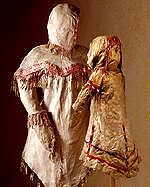
Athapaskan Women's Costumes and Ornaments
 |
(a-e) Tahltan Athapaskan women's ornaments, pre-1915; collected by J.A. Teit, 1912-1915, at Cassiar and Bear Lake, British Columbia In ancient times the Athapaskans (Dene), who lived in northwestern Canada and Alaska, observed strict rituals and taboos to ensure their safety and well-being. Some of those affecting women are illustrated here. The Athapaskans believed that menstrual blood offended animal spirits and that contamination would adversely affect hunting success. At the onset of menses, girls were secluded in huts for long periods, during which they wore fringed hoods like the one here. The hood was to prevent them looking on the faces of hunters; it was believed that, if they were to do so, the hunt would be unsuccessful and members of their lineage might become ill or be killed by vengeful spirits. They drank only from drinking tubes, which might have a grease bag attached; smearing grease on the mouth was intended to reduce the need for food. A necklace like the one at lower left and the collar to its right indicated that a girl was ready for marriage. The weighted ornament at upper left was attached at the back of the head to stimulate hair growth. Widowhood also had its taboos. During the bereavement period, the widow wore a necklace like the one at centre top. A head scratcher was necessary because she did not comb her hair during all that time. |
 |
Woman's summer costume, ca. 1880; Koyukon Athapaskan, Yukon River region, Alaska/Yukon Territory; tanned caribou skin, dyed porcupine quills, seed and wooden beads, sinew; 104.5 cm. long CMC VI-I-80a-c Child's summer costume, ca. 1870; Koyukon Athapaskan, Tanana/Yukon River region, Alaska; tanned caribou skin, woollen cloth, cotton thread, sinew, red ochre pigment, glass and metal beads; 87.7 cm. long For ceremonies or on trading trips, women and children wore beautifully decorated garments like in this photograph. Red paint applied along the seams was believed to protect the wearer. Similar garments of both types were worn by adults and children of both sexes on special occasions during the summer. The costumes included trouser-moccasins, hoods and mittens. |
